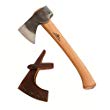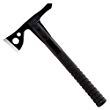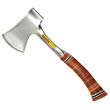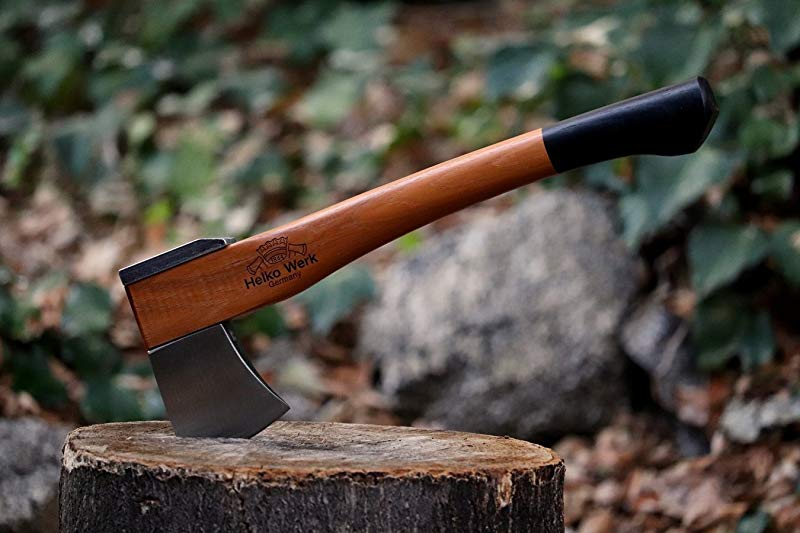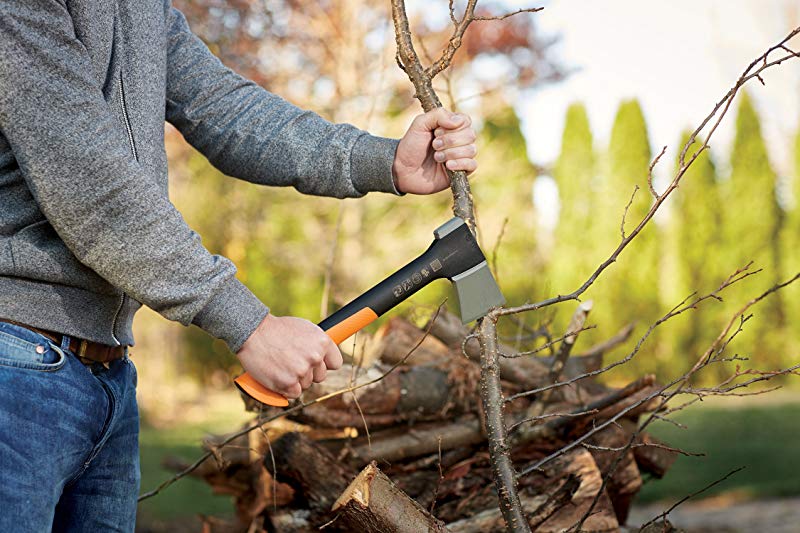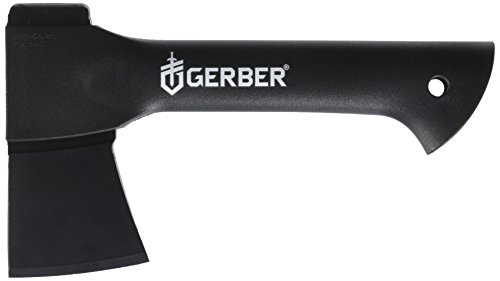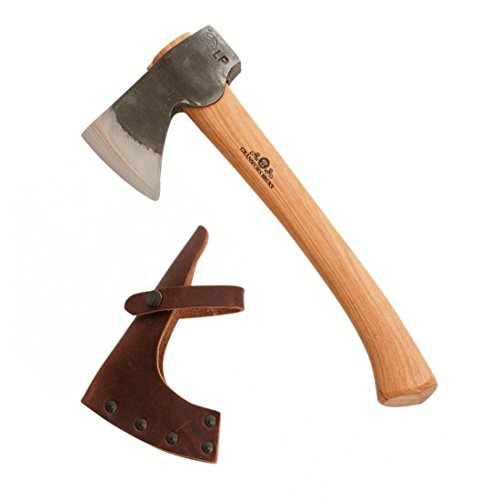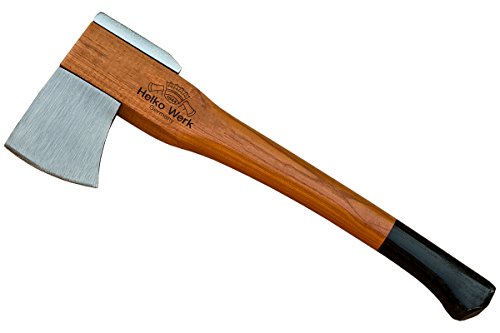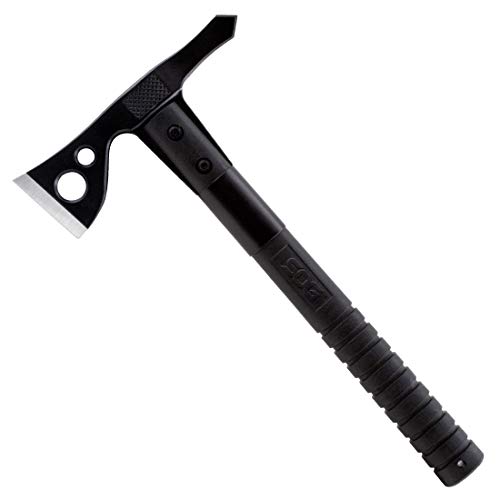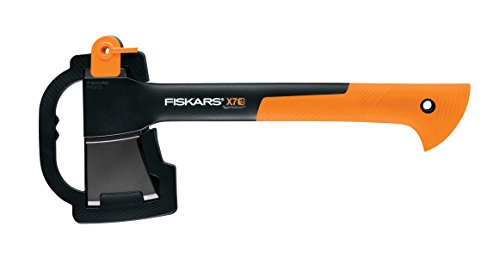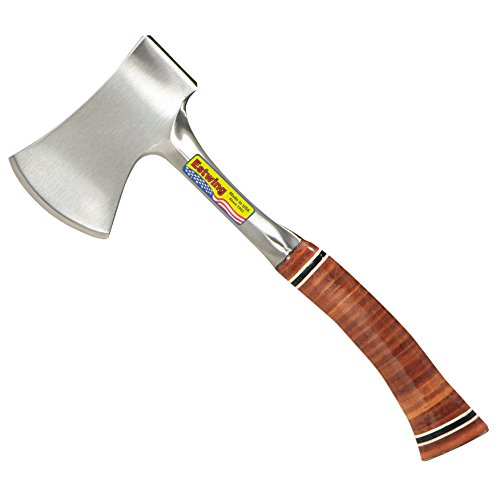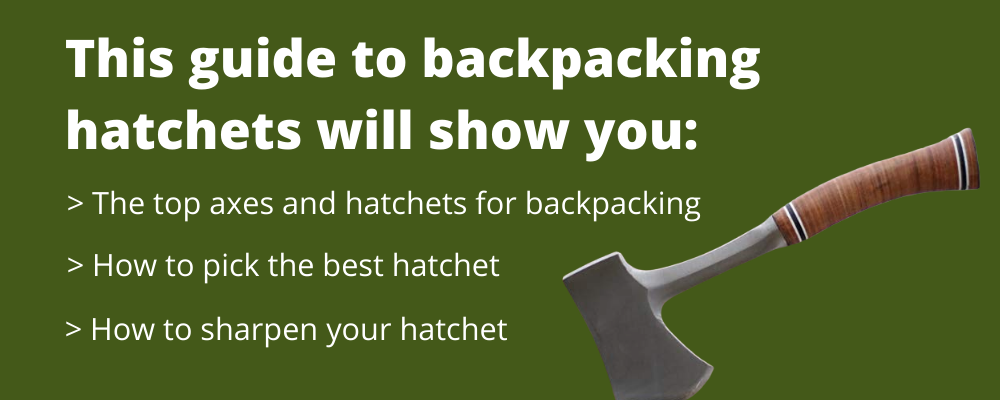
(updated in April, 2020 by Casey Fiedler)
The moment he shot his friend an awkward glance, I knew the guy had found my axe.
“So…. have you seen it?” I asked again.
A moment’s hesitation: “Yeah.” He pulled out my sleek little Gerber unit and plunged it into a nearby log.
More...
I don’t blame him for not wanting to give it up.
My backpacking companion and I had spent an hour struggling to bust up dried chunks of wood by hand in order to get enough starter fuel for a fire. But if I hadn’t dropped my micro-axe on the trail a few hours ago, the task would have taken us mere minutes.
So I was pretty happy to get it back. Not only because it’s useful, but also because that hatchet has been with me through a long list of knee-crippling treks.
OK, maybe I get a little sentimental about my bladed-tools. Tents, sleeping bags, and hiking boots come and go, but a good blade can last forever (unless you drop the damn thing). That’s why I’m writing a two-part Backcountry Blades series looking at some of the best hatchets and knives for backpacking – light, durable and ultra-useful. And FYI, these reviews do contain affiliate links.
If you’re hunting for an awesome little axe to add to your collection of camping gear, consider swinging one of the blades from the S&TT hatchet review.
Comparison Chart
Name | Price | Weight | Rating | Notes |
|---|---|---|---|---|
$$$ | 1.21 lbs | PTFE coated blade reduces friction, chops clean | ||
$$$ | 11 oz | Awesome little hatchet, so well made and useful for small tasks, carving, etc. | ||
$$$ | 1.3 lbs | The rubberized handle fills your hand to create a lock-tight grip that won’t let go even when wet. | ||
$$$ | 3 lbs | German C50 high grade carbon steel, 53-56 HRC | ||
$$$ | 19 oz | HANDLE IT ANY WAY YOU WANT: Throw it at stuff, chop stuff, hammer things | ||
$$$ | 1.38 lbs | Perfected balance and power-to-weight ratio increases swing speed to multiply power, much like an aluminum baseball bat | ||
$$$ | 1.91 lbs | FORGED IN ONE PIECE – The most durable, longest lasting striking tools available | ||
$$$ | 2.2 lbs | Head is attached to the hickory shaft using both a wooden and steel wedge to secure fastening | ||
$$$ | 1.01 lbs | Small forest axe, camping hatchet and backpacking hatchet features a 3.1-inch blade | ||
$$$ | 1.3 lbs | Full tang construction means steadiness in hand and the strength to power through swinging chores | ||
$$$ | 1.81 lbs | Camp axe ideal for camping or backyard | ||
$$$ | 2.2 lbs | Full Combo Includes A Plastic Sheath and A Fire Starter (Optional: Combo with Knife) | ||
$$$ | 3.09 lbs | Perfect for chopping logs, small trees & branches or splitting firewood & kindling | ||
$$$ | 2 lbs 12 oz | Axe head is hand-forged and made from Swedish axe steel in a foundry that has been in operation since 1697 | ||
$$$ | 1 lb 14 oz | Head weighs 1 lb. 5.6 oz.; head shape is the German Rheinland pattern which offers a larger, curved cutting surface |
How to Choose the Best Backpacking Axe for You
Choosing the Right Steel Type
Since I was a kid I’ve always been interested in medieval history – mostly the whole “swords and armor” bit. Of course, as I grew up that interest turned into a hobby. In fact, I launched a blacksmithing business in 2016!
That said, I do know a thing or two about the metals used in blade making today. I also know how much myth and mystery surrounds what is or isn’t “the best steel”.
Generally speaking, as far as a backpacking hatchet is concerned, anything except true mild steel can be considered an acceptable blade material.
Specialized steels, designated by letter combinations, can be sometimes employed to great effect in certain blade making endeavors. However, since the hatchet is such a thick, shallow bevel, blunt force object (compared to something like a straight razor) I feel steel choice is largely less important than in some cases.
O-1 steel, or a basic oil-hardening steel would be a fine choice.
Basic high carbon steels such as 1065 – 1095 would be perfectly acceptable as well (and probably cheaper).
Of course, a standard high-chromium stainless steel will mean less worry about rust so if you don’t tend to take care of your tools, this may be a good choice. While stainless may lack the niche properties of some specialized steels, again, I feel it’s a relatively moot point considering the job an axe is designed to do. Plus it may be one of the cheapest steels you can get.
If you are searching for a hatchet that will sharpen to shave with and hold an edge then a properly heat-treated 1085 or 1095 blade will probably keep you happy. Of course, just remember to keep your expectations within the bounds of the job for which a backpacking hatchet is meant.
Axe Accessories
For backpacking, I always recommend a blade cover. Either buy one with a nice Kydex and nylon blade sheath or make a nice leather one yourself. You really don’t want to gash your arm on the axe if you keep it lashed to the outside of your pack, and storing it inside the pack can cut the fabric of your pack or ruin other objects with an exposed blade.
Some axes feature blades with bottle openers, nail pullers, or specialized hammer faces on the butt of the axe for example. Search for the options that make sense for your uses and you’ll be happy.
Extra wedges can be very handy but you’ll rarely see an axe sold with them. You can buy or make extra metal or wooden wedges which I recommend you carry on your person for repairs in the field.
Sharpening hones are a matter of much contention in the world of blades. Regardless of your school of thought or approach, a good hone can be handy. However, I’d argue that for a working axe a small fine tooth file would be even more useful in the field for maintenance. Carry both if you want. Or check out this list of axe sharpeners.
Overstrike protectors come in many shapes and sizes. Usually made from metal or rubber, they protect the haft of the hatchet from impact due to missing your target. This is critical if you have bad aim or if you’re doing splitting work. One miss with a wooden handle can mean a shattered haft and a useless hatchet (I should know, I’ve done it!)
Axe Weight
When it comes to axe weight and size, I think what we need to focus on is that we’re carrying this thing backpacking. We’re not talking about the fine points of blade design for hewing, bucking, felling, and framing. No, we’re looking for a good all-around utility tool we can carry backpacking.
For that reason, I think we want to keep our eyes set toward lightweight hatchets. These little axes aren’t going to weigh us down too much as we carry them around. Remember, you’ll be carrying it while you hike for 8-12 hours a day and using it for a few minutes each evening if you even have the stamina left to make a fire after your hike.
I recommend looking for something the reflects how often you’ll use it. If you’re going into the woods primarily to practice axe skills – take a bigger axe. If you’re going primarily to hike – take a smaller hatchet.
Try not to overthink it.
Handle Length and Material
Handle length can vary from about 16″ to 36″ on these style of hatchets. Similar to the weight of the head, the length of the handle should be chosen based on how much use you plan to get out of it.
For occasional use, go shorter. It’s easier to pack and carry on the trail and that’s a major advantage for backpacking.
If you plan to spend a lot of time in camping working with your hatchet while on the trail, consider going moderate to long on your handle choice.
Handle length is also very important in picking the correct tool for the job. However, as we spoke earlier, we’re looking for a “do it all” hatchet for backpacking which means we should probably keep your expectations in the middle of the range.
As for handle material:
Wood Handles:
Finding the perfect wood handle is unlikely. They tend to be badly made and coated in a urethane covering which makes them slippery.
You may have to do some sanding, shaping, and treating of the wood handle that your hatchet comes with in order to make it properly usable.
Plastic and Fiberglass
A good fiberglass handle on a hatchet can be lightweight and highly durable. If you do manage to damage the handle, however, expect awful fiberglass splinters and a huge pain to replace the handle.
Best Backpacking Hatchets 2020
For obvious reasons, I just have to put this one at the top of my list. I’m a big fan of Gerber products and this 9-inch hatchet is among my faves.
With a hollowed-out hard-plastic handle, this tool weighs only 19 ounces so it’s great for backpacking. I’ve been wailing on my Gerber axe for four years now and it’s withstood the test of time. Sure, you don’t have the kind of leverage you do with a larger axe, but this little number still packs a surprising amount of cutting power. Super-handy for hacking down firewood.
The axe is quite durable as well. Most Gerber blades tend to dull a tad sooner than other products, so if you’re expecting heavy use out of this thing be sure to bring a sharpener with you on the trail just in case.
Overall, this axe does what it’s supposed to do well. Just remember: if you’re securing it to your backpack, make sure the Velcro strap is done up. I figure that’s how I lost mine on the trail. You can get this hatchet on Amazon for about $39.
If I actually did lose my Gerber axe for good, this would be my next choice. Well, if I could afford it.
The folks at Gränsfors Bruks make one mean hatchet. Each of these axes is forged by hand. Once the smith is 100% satisfied with the product, he stamps the head with his initials next to the company’s crown logo. We’re talking primo Swedish craftsmanship here.
Unlike most hatchets, no metal wedge is used to attach the head to the handle. This is a rare trait for a hatchet since it takes a highly skilled smith to forge a small axe with a hole in its head. The result? One ultra-durable hatchet that can take a beating.
The Gransfors Bruk Mini Belt Hatchet weighs in at a mere 11 ounces. The price for such a gem? About $190. Yeah, it ain’t cheap. But if you want the absolute best, this would be it.
If you can get past the silly Bear Grylls endorsement you’ll quickly see the advantages of this little axe.
Single piece construction is great, as the haft of the axe extends all the way through the handle. Labeled 3Cr13MoV steel (ultimately just a modified 420 stainless) Gerber has unfortunately made a choice of steel here which really only serves to confuse the consumer.
Granted, at the $30 price point it’ll be hard to complain about the steel choice but I’d personally like to see a lot more disclosure of steel choice and heat treatment specifications to really feel good about this little axe.
Despite the somewhat mysterious steel, the Gerber Bear Grylls Survival Hatchet is a very useful tool at a wonderfully budget price. Weighing just 1.4 pounds, and having a hypercompact profile, it’s absolutely a reasonably lightweight tool for carrying.
This one gets a nod for trail crews and heavy lifters in the backcountry. If you’re backpacking in to do some trail work this might be your axe.
The coolest feature? Interchangeable heads. Just unscrew the head of the axe and go from felling axe to splitting maul without carrying separate full-size tools.
An 18″ full length makes it reasonable to carry yet long enough to get a decent swing. Perhaps somewhere between full-size function and compact portability.
Again, however, I am disappointed in the manufacturer’s choice of steel. C50 is a mid-carbon steel which is also known as 1049 or 1050 in the US.
Since I first wrote this article, they’ve actually updated the axe head steel from 1040 to 1050 which is minor but important. While 1050 might not be considered by many to be the “top of the line” I think it’s an acceptable choice and a warranted improvement of this hatchet.
This hatchet also earns top points for aesthetics in my book.
Seemingly a strange choice for this list, the SOG hawk makes the cut based on a ridiculously budget price, lightweight, and near bombproof build. As backcountry guide and outdoors blogger Casey Fiedler puts it:
"I’ve personally had my hands on this fun little tool and I can say: it’s a pleasure to wield. Despite repeated attempts to hack, punch, and chop through cans, bottles, logs, and other completely inappropriate axe targets, this hawk keeps on chugging.
My recommendation? Use a hot nail to give the plastic handle a dotted textured grip surface for improved grip.
The SOG hawk holds a reasonably sharp edge remarkably well from experience.
Did I mention that I’ve used this little guy as a throwing tomahawk for years and, despite hundreds of handle-first impacts, it has yet to show damage? It seems I can’t destroy it, despite my best attempts at it."
Because of the thin, sharp blade and the lightweight head you can swing this hatchet with some serious force. It makes quick work out of logs, trees, and branches that are seemingly too large for it to tackle, yet it does so with aplomb. Further, thanks to the lightweight sharp head you can use it to easily cut small green branches that other axes would simply mangle.
Coming in on our list update this year is the Fiskars X7 hatchet for backpacking. Of course, they didn’t make it specifically for backpacking but I think it deserves a consideration.
With a 14″ handle it’s compact and lightweight. It also features that solid wrap-around handle build that forgoes the traditional eye design in favor of a more “one-piece” style modern construction.
The thin blade and aggressive bevel angle mean that this blade should be ready to chop hard and fast. It’s going to be a deep diving cutter for delimbing and felling small diameter wood.
Since the blade has very little width, however, it’s going to be an absolutely terrible choice for splitting wood. Plus the handle bisects the blade about halfway back with a very sharp protrusion which will get in the way of splitting attempts.
Use this hatchet for light, fast work like making lean-tos or bucking small limbs. (Bonus: it comes with a nice blade cover.)
There’s something about this hatchet that screams Americana in the days of Buddy Holly and Ritchie Valens (sorry Bruce, you’ll come later).
It doesn’t get much more classic than the stacked leather disc handle although I have one major problem with it. They lacquered the leather handle which means it’s going to be slippery! One of the best parts about stacked leather handles is that they absorb sweat and improve grip so I’d recommend lightly sanding it back down to bare leather.
Other than that, the stainless blade is a one-piece forged construction that goes right down the handle in a full-tang style. That means overstrikes aren’t going to hurt a thing and the hatchet will remain nearly indestructible unless you put it through a foundry furnace!
This is the hatchet your daddy’s daddy carried in the Boyscouts and today it still remains a viable (if not superb) choice.
You might know Husqvarna from the Home Depot where they sell bright orange lawn mowers with the big H on the side. Just so happens, they also make hatchets and axes.
True to modern tastes, they left this hatchet head roughly finished after a quick bevel sanding and blackening. It looks “handmade” and it may even have been manually fed into the drop hammer or press, but it certainly wasn’t forged in the fires of Mount Doom.
That said, the price is right and this hatchet comes in tons of styles, lengths, and designs. If you don’t want the wooden handle you can get the composite handle instead.
One thing I do like about the composite handle hatchets and axes from Husqvarna is that they have a properly positioned metal overstrike protector. This is especially helpful for splitting work or those who aren’t confident with their aim!
SOG already made it onto our list with the classic Tactical Tomahawk but they’re back. This time the tacti-hawk takes a more practical approach.
Instead of the armor-opening spike on the back of the hatchet, this one has a more reasonable hammer face instead. This is great for all sorts of work around camp (though beware of breaking tent stakes). Overall, a more sensible build for camping and hiking.
At 11.5” overall it’s practical. It also has a great overstrike protector made from stainless steel which helps with durability. Best of all is the nylon blade cover to keep it from cutting through your backpack when stored.
Gerber stepped up their game by refining their classic hatchet and aiming it right at the backpackers among us.
One-piece coated steel uses a full tang construction. This is by far the most durable construction method for these types of hatchets and it ranks highly in my book. At the end of the nylon handle is an integrated lanyard hole.
To note is a small hammer face on the back of the hatchet. Additionally, the rubber palm and finger grip helps add a tacky grip that’s easy to hold.
Hear me out on this one…
While I’m not here to argue that this hatchet is of the highest quality, I am advocating that it might be the highest value.
I’ve owned this exact hatchet since I was a kid. Over the years, and particularly as a kid, I’ve subjected it to cutting everything from wood to steel. I’ve thrown it, smacked, bashed, and hacked with it. Even the rubber handle fell off eventually.
Through all that, however, it never gave up, never broke, and was always easy to re-sharpen. So, for the price tag that comes in at a fraction of other hatchets, I’m willing to say this might be a top choice for those looking to find value.
This axe packs in the features and extras like no other on our list.
Inside the 12” handle is a wood saw that can be pulled out and used for fine cutting. Meanwhile, the 420 stainless steel blade is protected by a molded nylon sheath. In the sheath is a ferrocerium rod for starting fires, too!
If you’re a fan of the multi-tool then this might be the right axe for you. It’s practical, durable, and multi-functional. Simultaneously this may be the biggest drawback of this axe. It does a lot of things okay, but it does nothing perfectly.
A longer handle with the same solid single-piece forged construction we’ve seen before means a workhorse of an axe.
This one is made from a single piece of forged stainless (drop forged in a factory). They’ve also added a shock reduction grip that helps ease fatigue. Maybe the biggest feature difference is the longer 16” handle-to-blade measurement.
While it’s almost too long for backpacking, 16” is just small enough to fit in most internal frame packs or strap on the outside of any pack comfortably. If you prefer camping and hacking away with your hatchet over saving weight - this is the tool for the job!
If you’ve given up on going lightweight and need to take the big guns, look no further.
This traditional-style wood handle and forged bit axe is gorgeous and effective. At a total weight of nearly 3 pounds, however, it’s just not an option for the lightweight purists among us.
The hickory handle is beautiful and the forged “Swiss steel” bit strikes a nice contrast. At the end of the day, however, the manufacturer discloses little detail about the steel treatment or composition. Additionally, the wood handle may be more vulnerable to overstrikes and breaking than modern composites.
For all those reasons, I think this axe makes sense for those who have an eye for aesthetics and intend to use their camp axe often to justify the weight.
Maybe one of the best blends of aesthetics, performance, weight, and price is the Adler German Axes Rheinland.
At 14” this hatchet is an ideal pack size that’s also still big enough to do some work. Coming in at almost 2 pounds it’s also heavy enough to really chunk away at some wood.
It’s worth noting that Adler is a certified “Made in Germany” factory so they stand by their word. Additionally, their products are tested and verified by the VPA - an objective testing center.
Unlike some companies, I trust that their bits are actually made with the stated C45 steel and hardened to the stated 47-55 Rockwell.
Ultimately there’s not a lot to love about this moderately priced, well-rounded axe for backpacking and camping.
How to Sharpen Backpacking Axes
When it comes to answering this question, there are a lot of ways we could go about it. Of course, at the end of the day, there is indeed more than one “right” way to sharpen an axe depending on what tools you have and what you’re trying to accomplish.
Sharpening a Damaged Axe Head
If your bit has chipped or dinged at the head you may need some serious intervention.
Start by filing or grinding the blade away until the blade has a smooth even taper free from dings and nicks. Yes, literally grind the blade flat until the nicks are gone.
Now, using either an electric grinder (bench grinder, Dremel, angle grinder, etc.) or a file you’ll want to slowly restore the edge. Start with a grinding stone or grinding bit and put a rough edge back on. Then move to a sanding bit or flap disc for the angle grinder and work your way up to about 200 grit.
In all reality, this should be a sufficient edge for the vast majority of applications. If you want a mirror-smooth blade, however, you’ll have to keep working your way up the grits.
Be careful as you work to remove as little material as possible while maintaining the original symmetry of the bit.
Sharpening a Lightly Used Axe Head
If there are no major dings or nicks your job is much easier. All you’ll need to do is carefully restore the edge of the blade.
Blades that haven’t seen a lot of damage can be re-sharpened using stones, sandpaper, or sometimes even a buffing wheel.
For axe blades, we don’t want too sharp of a blade. Overly thin blades, while very sharp, are also prone to chipping in high-abuse scenarios such as those we subject axes and hatchets to. Therefore you want to sharpen your axe to a relatively steep final bevel angle and don’t go too crazy making it into a razor blade.
I would recommend a high-grit Dremel sanding drum or flap disc for the angle grinder. Something in the 200-300 grit range for sharpening a lightly used axe. Alternately, you can use a whetstone or very fine-toothed file.
One popular option is a dual-grit stone such as the Lansky Puck. With a coarse and medium side, you can start hard and finish easily as you refine the edge on your axe. This is a good option to take with you in the field.
While I might argue that at home there are easier ways to sharpen an axe, in the field a file or stone is an ideal option!
If you want to see one way to approach the process of sharpening an axe, this is a great tutorial video...
Understanding Burrs
When sharpening any blade, a bur is your worst enemy. Now, with axes, it’s maybe somewhat of a moot point. Given that most axes have a relatively dull blade to begin with (making them razor sharp defeats the purpose) burrs aren’t as pesky.
That said, however, you’ll still want to avoid major burrs and curls.
When sharpening a blade with any instrument a burr can form. Metal at the very edge of the blade gets so thin and fragile (think thinner than a hair) that it can curl over much like the barrel on an ocean wave.
These curls and burs decrease the overall sharpness of the blade. While the context is different, this video talks a lot about burs and how to sharpen to avoid them.
Drop by next week for part two of the Backcountry Blade series, which will highlight six of the best pocket knives.
Do you prefer the trails less traveled?
Join like-minded trekkers by signing up for the S&TT e-mail list. Every week, you’ll get:
- Profiles of little-known hiking destinations
- Gear reviews for backpackers and hikers
- Feature articles on strange and off-beat hiking
Plus we’re 100% spam-free (and proud of it)


